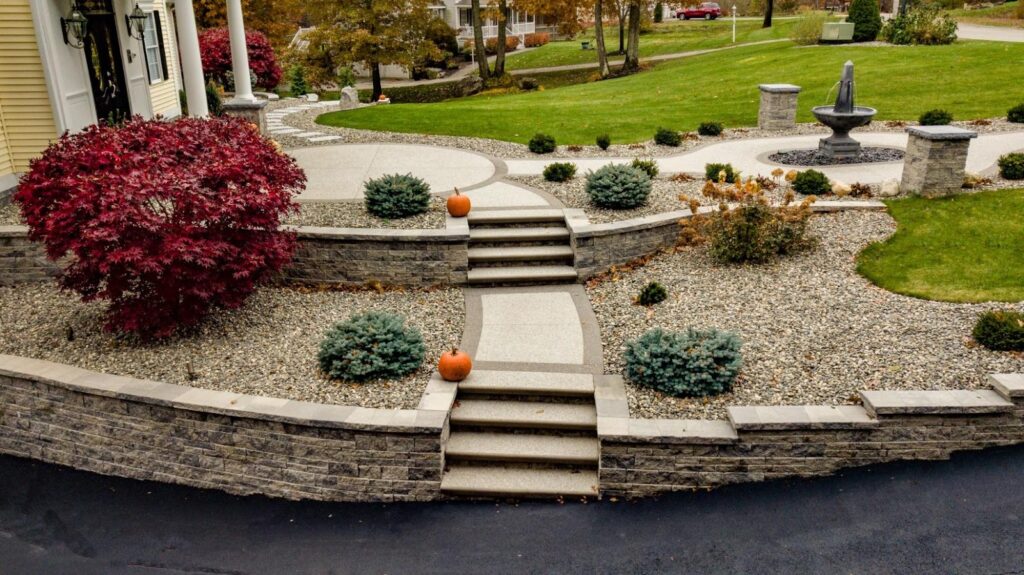Landscape engineering has taken a progressive step forward with the advent of advanced retaining wall systems. These structures are more than just functional; they have become an integral part of modern landscape architecture, transforming outdoor spaces into aesthetic, durable, and sustainable areas. This article explores how these systems enhance the environment, addressing the engineering challenges they solve and the benefits they bring to both public and private lands.
The Function of Retaining Wall Systems
Retaining walls serve a critical role in landscape engineering. The primary function of these systems is to support and retain soil at different levels on either side of the wall. This is particularly important where the landscape’s natural topography presents steep slopes that are prone to erosion or where elevation changes are necessary for construction purposes.
Modern retaining wall systems have evolved from mere functional barriers to sophisticated engineering solutions that contribute significantly to the aesthetics and serviceability of outdoor spaces. With advanced materials and design, these systems effectively manage earth and water, preventing the downslope movement of soil and erosion which are critical in safeguarding structures and maintaining the integrity of landscapes.
Materials and Design Innovation
The materials and design of retaining walls have undergone significant innovation over the years. Modern retaining walls utilise a variety of materials including stone, concrete, steel, and even synthetic fabrics. These materials are chosen based on factors such as local environmental conditions, the desired lifespan of the wall, and the aesthetic preferences of stakeholders.
Engineering design in retaining wall construction has equally improved, with considerations for factors like soil strength, drainage, foundational support, and environmental impact. The contemporary approach to wall design often includes considerations for green spaces, integrating features like planters to encourage greenery and contribute towards environmental sustainability.
Engineering Challenges and Solutions
Retaining walls are subjected to significant forces, both from the earth they retain and environmental elements like water and wind. One of the biggest challenges in their construction is ensuring stability under these forces. This requires precise calculations regarding load-bearing capacity, wall angles, and support requirements.
Another engineering challenge is drainage. Without proper drainage, the build-up of water behind the wall can lead to increased pressure and eventual failure. To mitigate this, engineers design comprehensive drainage systems that divert water away and reduce hydrostatic pressure on the walls. The use of weep holes, drainage tiles, and gravel backfills are common solutions to this problem.
Benefits of Advanced Retaining Wall Systems
The benefits of incorporating retaining wall systems within landscapes are multifaceted. Structurally, they provide the necessary support where elevational differences exist, creating usable flat areas on sloped terrains. This supports the creation of building foundations, roads, and other infrastructure that require level ground.
From an environmental perspective, they minimise soil erosion and the sediment run-off that can pollute waterways. By holding soil in place, retaining walls conserve the soil’s nutrient levels and prevent degradation of the site, contributing to a more sustainable landscape management approach.
Aesthetically, retaining walls have the potential to enhance the visual appeal of outdoor spaces. With custom designs and finishes, they can integrate seamlessly into various landscape themes, from natural and rustic to sleek and contemporary.
Retaining Walls in Urban and Rural Landscapes
Both urban and rural landscapes can benefit from the implementation of retaining wall systems. In densely populated urban settings, they facilitate the maximisation of space and can serve as noise barriers, privacy screens, or even vertical gardens. In rural areas, they are critical in preserving the integrity of agricultural land, supporting terraces for farming, and stabilising banks of water bodies to prevent erosion.
Moreover, the versatility of retaining wall systems means they are not just for large-scale projects. They can also be adapted to smaller residential settings, allowing homeowners to create terraced gardens, driveway boundaries, or elevate patios for an enhanced outdoor living experience.
Conclusion
Advanced retaining wall systems are an essential component of modern landscape engineering. They address a host of functional challenges, from preventing erosion to enabling the creation of level terrains for development. With design innovation and the right materials, these structures offer robustness, aesthetic value, and environmental benefits, playing a pivotal role in outdoor space enhancement. As landscape demands grow and evolve, retaining wall technology is sure to advance even further, offering improved solutions for a harmonious integration of human activity with the natural environment.
It is evident that the proper implementation of advanced retaining wall systems is vital to landscape engineering. They represent the synergy between human ingenuity and respect for the natural world, and their role in shaping and protecting our environment cannot be overemphasised. As we continue to engineer our surroundings, it’s essential that sustainable practices and innovative design remain at the forefront, ensuring our outdoor spaces are not only functional but also aesthetically pleasing and environmentally conscious.

